| Versailles | ||
|
|
The Versailles Palace is located southwest of Paris in the suburb of Versailles. Originally this was the site of a hunting lodge for King Louis the Thirteenth (1601-1643, rule began in 1610). It was his son, Louis the Fourteenth, the Sun King (1638-1715, rule began in 1643) who expanded the imperial palace and decided to use much of the wealth of France to create Versailles on a tremendous scale of construction. From the early to mid-1660s onward, King Louis XIV had the landscape and garden architect André Le Nôtre, the architects Louis Le Vau and Jules Hardouin-Mansart, and the decorator and artist Charles LeBrun participate in the design and construction of the Versailles Palace. The construction of the palace and the engineering and construction of the grounds and gardens around it was concentrated between 1668 and 1684, although some construction began earlier and continued to 1710. The Sun King Louis XIV transfered royal power from Paris to Versailles Palace in 1682 to weaken the aristocrats’ strength and increase his own authority, which helped him to concentrate his power. Versailles Palace was the home for the royal family of France from 1682 to 1789. The Baroque style of architecture characteristic of Versailles Palace impresses people by its luxury, with colossal murals, rows of monumental statues, and an immense collection of fine furniture inside the palace. The stunning geometric design of the garden and the great fountain outside in the yard. The scale and style of the place shows the world without doubt about the power, the glory, and the wealth of the French monarchy in that period of French history. Mark Twain said of it, “You gaze, and stare, and try to understand that it is real, that it is on the earth, that it is not the Garden of Eden . . .” The palace has a quite famous main hall called The Hall of Mirrors (La Galerie des Glaces). The hall has mirrors along a wall with 17 arches. This wall is symmetrical to the facing side of the hall where 17 arches and French windows open to the gardens. In the hall hangs crystal chandeliers, making it easy to imagine imperial family aristocrats enjoying luxurious dance parties. During the French Revolution in 1789, the angry common people took King Louis the Sixteenth from Versailles to Paris, and looted the Versailles Palace. Prussia’s King William the First was made emperor of Germany in a coronation ceremony within the mirror hall in January of 1871. On June 28, 1919 the Versailles treaty was signed in this hall, marking the official conclusion of the Great War, the first stage of the twentieth century’s world wars. The Versailles Palace is open to visitors, although it is sometimes used for official government functions. |
|||||||||||||
Links about Versailles:
|
| Back to the Seventeenth Century Timeline | ||
| Back to the World History Timeline in English | ||
| Back to the Historylines home page. | ||
Photo Gallery of Versailles. All photographs by Virginia Ives. |
 |
 |
 |
|
| The Sun. King Louis the 14th of the House of Bourbon was called "The Sun King." | A symbol of Louis XIV, the Sun King, this medallion decorates the palace of Versailles. | A heroic statue of Louis XIV, who ruled France from 1643 to his death in 1715.
|
|
 |
 |
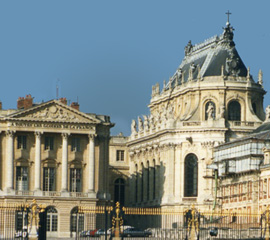 |
|
| The main chapel in the palace of Versailles. | The gate into the palace of Versailles. | The roof of the chapel and palace.
|
|
 |
 |
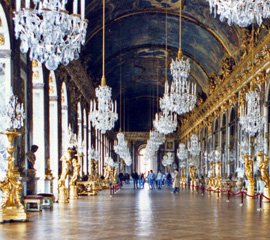 |
|
| This is what the interior of the Palace of Versailles looks like. | Here is the famous Hall of Mirrors Jules Hardouin-Mansart designed. | The Hall of Mirrors stretches out to about 73 meters (about 239 feet).
|
|
 |
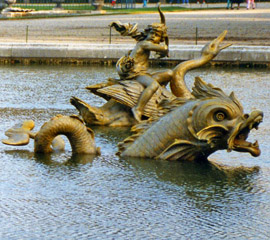 |
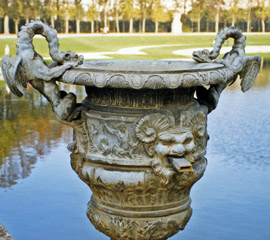 |
|
| A statue (of the Rhône River personified) at the water terrace. | The Neptune Basin has many fantastic fountains and sculptures. Is this Apollo, symbol of the sun, riding a swan? | The Versailles gardens have decorative urns and vases as well as statues and fountains.
|
 |
 |
|
| A map of the Palace of Versailles. | A timeline from the literature given to visitors to Versailles.
|
|
 |
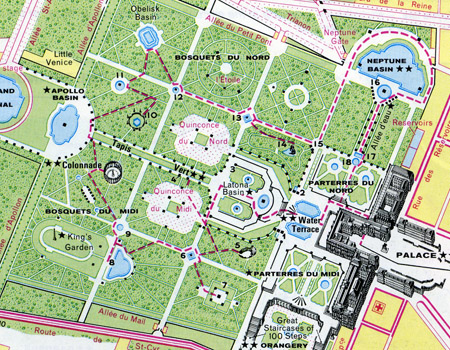 |
|
| A map of the park and grounds at Versailles. | A map of the gardens around the palace at Versailles.
|
|
| Back to the World History Timeline in English | ||
| Back to the Historylines home page. | ||
| Articles of French history: Paris Opera, Eiffel tower, Notre-Dame de Paris, Louvre | ||
|